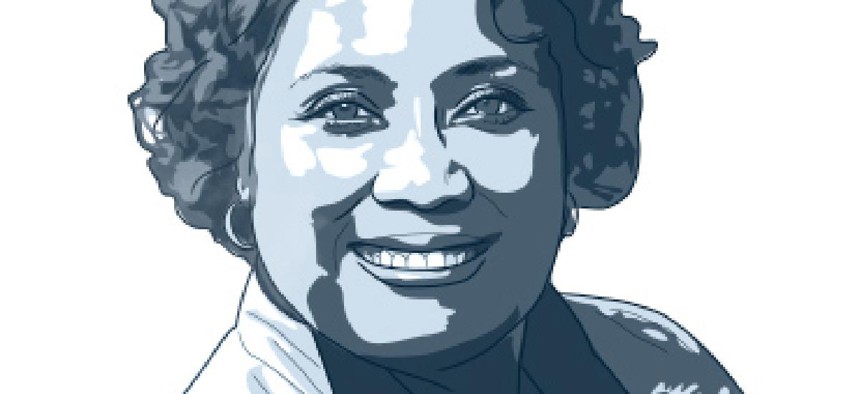As NASA CIO Linda Cureton leaves government for the private sector, she offers some parting thoughts on the changing role of the federal CIO.

As NASA CIO Linda Cureton leaves government for the private sector, she offers some parting thoughts on the changing role of the federal CIO. (FCW image)
There’s a lot of discussion about the efficacy of the Clinger-Cohen Act as it relates to creating the role of agency CIOs. At the end of the day, it is clear that what we need is not just a new piece of legislation. We as federal CIOs need to change and redefine ourselves as the New Federal CIOs.
What problems do we see in government? We often hear about the big three: IT governance, mission alignment and stakeholder engagement. We focus a lot of attention on organizational positioning, technology solutions, managerial span of control and expertise. However, we need to reconsider our leadership roles and shift our focus to the CIO as social worker, CIO as communicator and CIO as mission IT expert.
CIO as social worker
A social worker brings people together and helps facilitate a path toward problem resolution and self-actualization. The CIO as social worker would perform in a similar manner. Let’s consider briefly the lessons from Winnie the Pooh. The CIO as Winnie the Pooh sounds strange, I admit, but there are lessons to learn there.
In his book "The Tao of Pooh," Benjamin Hoff talks about leadership that is effortless, without "meddlesome, combative or egotistical effort." He goes on to illustrate the concept with Pooh-like banter: "Just how do you do it, Pooh?"
"Do what?" asked Pooh.
"Become so Effortless."
"I don’t do much of anything," he said. "But yet all those things of yours get done."
"They just sort of happen," he said.
This exchange describes the Tao concept of wu wei. It requires working with the natural order of things to get stuff done. We don’t jam square pegs into round holes. Rather, we work with the circumstances, understanding why they work and how they work in order to make things "sort of happen."
As CIOs, we often try to jam square pegs into round holes without understanding the circumstances of our customers or our organizations. We are strong intellectually and try to find clever ways of shaving the sharp edges off those square pegs. A lot of energy gets expended, and sometimes we find ourselves cut and bloodied by the process.
What the New Federal CIOs should do is spend time with the mission and with their customers. In doing so, we will find out what their problems and needs are. We can then devise solutions and strategies that satisfy their IT needs in a more meaningful way. We will be able to get things done, and stuff will just sort of happen.
CIO as communicator
As technologists, we often see the world as ones and zeros. We are binary, linear and logical, and (we hope!) communicate clearly and accurately. Our audience is forced to understand our technology, our government agencies’ organizational structures, and the differences among our agencies and our programs. The new Digital Government Strategy encourages us to look for more meaningful ways to communicate with citizens. I say amen.
The time is over for CIOs to grouse about the mission relevance of social media tools such as Facebook, Twitter, YouTube, etc. The power of this technology can be found in its perceived weakness. It is skewed, random and disorganized — perhaps closely mimicking the workings of the human brain. Using this technology, we are thus able to communicate in ways that are more personal and less sterile and bureaucratic.
Consider NASA’s anthropomorphic Phoenix Mars rover, which tweeted, "We have ICE!!!! w00t!!!"
That has a bigger impact than saying, "At 20:19 PST the National Aeronautics and Space Administration is cautiously optimistic that there is a high possibility that ice, and therefore, water exists on Mars. Scientists will continue to analyze the results."
So come on, New Federal CIOs — let’s start using this technology in all earnest. Don’t limit it to check-the-box blogs, but interact both personally and professionally. The world has already passed you by.
CIO as mission IT expert
Way back in 2005, Marianne Broadbent and Ellen Kitzis got it right in "The New CIO Leader." CIOs need to strike the right balance between the supply side and the demand side of the world of the CIO. We have a tendency to get mired in the important but routine supply-side issues of service delivery, team building and risk management. That is clearly necessary but hardly sufficient for the New Federal CIO.
We have argued continuously about CIOs having a "seat at the table." But where we sit is not nearly as important as where we stand. And we must stand for leading the tireless and often thankless job of shaping and creating an IT-enabled enterprise. We must stand for weaving and connecting mission requirements and technology solutions using an enterprise architecture that is usable and practical. We must stand for banishing the days of technology solutions looking for problems and cease the creation of reams of paper that barely relate to your ever-changing environment.
The New Federal CIO will bring all those roles together and create a new creature. None of this requires legislation. But it does require vision, courage and leadership — knowing that there is a better future, having the guts to stand up for it and stepping forward with the audacity of hope that energizes people. We will be criticized for the failings of our service providers, the security incident du jour and ever-decreasing budgets tightly coupled with increasing demands. Nevertheless, we must have tough skins and soft hearts — weathering the challenges that are before us but being ever diligent in meeting those challenges and living to face another fiscal year.






